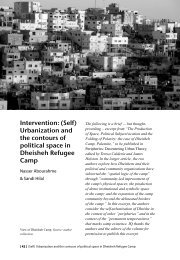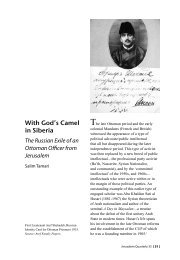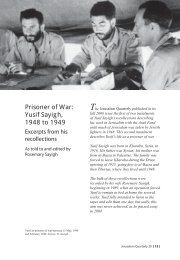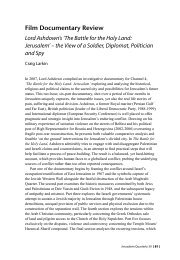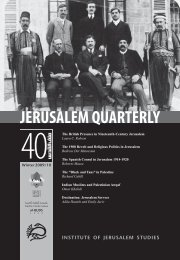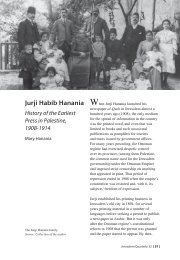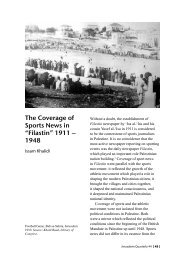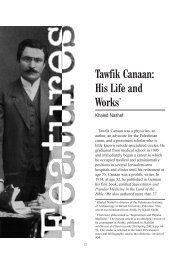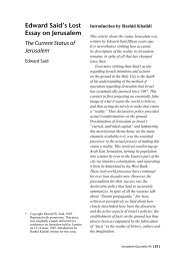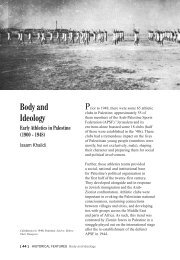PLUNDERING PALESTINE - Jerusalem Quarterly
PLUNDERING PALESTINE - Jerusalem Quarterly
PLUNDERING PALESTINE - Jerusalem Quarterly
Create successful ePaper yourself
Turn your PDF publications into a flip-book with our unique Google optimized e-Paper software.
as a springboard, and in consultation with archaeologists and government officials,<br />
Garstang established an antiquities ordinance vesting the ownership of moveable and<br />
immoveable cultural heritage in the Civil Government of Palestine. The enactment<br />
of this ordinance ensured that the protection and oversight of cultural heritage in<br />
Palestine was carried out locally rather than from a colonial capital.<br />
The primary goal of the AO 1920 was the protection of archaeological antiquities 20<br />
and sites. The regulation of ongoing archaeological excavations was monitored by<br />
the Department of Antiquities, as was the sale of artefacts. In response to criticisms<br />
of the earlier 1884 Law by archaeologists and tourists regarding the lack of access to<br />
archaeological material, a provision was included for the sale of material deemed not<br />
required for the national repository–a decision to be made by the director of the DOA<br />
and its advisory board. The department was given permission by the High Commission<br />
to issue licenses for the trade in antiquities. In 1920, for the first time, a licensed trade<br />
in antiquities was regulated and overseen by a bureaucratic entity–the Department of<br />
Antiquities. Article 21 of The Palestine Mandate of the League of Nations of 1922<br />
further cemented the right to scientific access for nationals and foreigners by insuring<br />
access to excavations and archaeological research for any member of the League<br />
of Nations. Scientific archaeological enquiry and the distribution of archaeological<br />
material took centre stage during the mandatory period, embodied in Antiquities<br />
Ordinance No. 51 of 1929.<br />
In 1929, Antiquities Ordinance No. 51 (AO 1929) was enacted by the High<br />
Commissioner for Palestine; AO 1929 now forms the basis for all current domestic<br />
legislation concerning protection of cultural property in Israel and Palestine. 21 Under<br />
this ordinance, the definition of buying and selling of artefacts is clearly spelled out<br />
starting with a basic definition of “to deal”: “‘To deal’ in antiquities means to engage<br />
in the business of buying and selling antiquities for the purpose of trade; and a ‘dealer’<br />
is a person who is so engaged in that business.” 22 Specific guidelines for obtaining<br />
licenses to deal in and export antiquities are outlined in the ordinance and in the<br />
accompanying Antiquities Rules of 1930 (AR 1930). Article 4 regulated matters of<br />
licensing, including: application procedures, duration of the license and criteria for<br />
obtaining a license; duties of the DOA in oversight of the process; and the requirement<br />
that each dealer inform potential buyers of the need to acquire an export permit.<br />
With the establishment of these provisions and guidelines the previously unregulated<br />
activity of selling artefacts was legislated. Palestinian and Jewish families who had<br />
been in the antiquities business for decades now had to apply for official permission,<br />
pay for a license, submit to inspections by the DOA and provide a detailed list of<br />
their inventory and sales. Many of these requirements for the sale of antiquities are<br />
enforced in the current trade in Israel. This system was/is not without its detractors.<br />
[ 26 ] FEATURES The Trade in Palestinian Antiquities



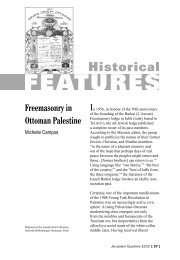
![In Search of Jerusalem Airport [pdf] - Jerusalem Quarterly](https://img.yumpu.com/49007736/1/180x260/in-search-of-jerusalem-airport-pdf-jerusalem-quarterly.jpg?quality=85)
